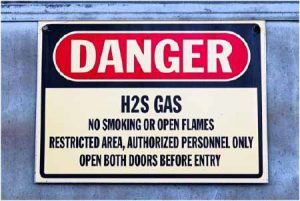 Hydrogen Sulfide, or H2S, is a toxic gas that is colorless and highly flammable. Other names for H2S include sewer gas, swamp gas, manure gas and stink damp. In addition to gas form, H2S can exist as a liquid compressed gas. H2S gas occurs naturally in hot springs, crude petroleum, natural gas and as a byproduct of decaying/decomposing organic material. However, it is also encountered in a diverse number of industries such as wastewater treatment, oil & gas drilling, refining, mining, pulp & papermill processing, agriculture, canneries, and construction.
Hydrogen Sulfide, or H2S, is a toxic gas that is colorless and highly flammable. Other names for H2S include sewer gas, swamp gas, manure gas and stink damp. In addition to gas form, H2S can exist as a liquid compressed gas. H2S gas occurs naturally in hot springs, crude petroleum, natural gas and as a byproduct of decaying/decomposing organic material. However, it is also encountered in a diverse number of industries such as wastewater treatment, oil & gas drilling, refining, mining, pulp & papermill processing, agriculture, canneries, and construction.
Your Sense of Smell and H2S
The primary route H2S enters the body is through inhalation. H2S smells like rotten eggs and can be smelled at very low concentrations in air. The smell should be a warning that the gas is present—H2S can be fatal, even at much lower concentrations than other hazardous gases. However, due to olfactory fatigue, at low concentrations or high concentrations, people can lose the ability to smell the gas. Repeated exposure to the gas can cause people to have reactions at progressively lower levels. Because of this, you should never rely on your sense of smell to indicate the ongoing presence of H2S. Instead, use proper testing and monitoring devices to detect H2S.
H2S and Confined Spaces
Your workplace may have confined spaces where there is H2S. Before entering an area where H2S may be present, many air tests must be conducted, the atmosphere must be monitored continually, and PPE must be worn.
Summary
If H2S is present at your workplace, there should be health and safety practices in place. Make sure to learn all you can about H2S and be properly trained and suited up before entering a hazardous environment.
BE AWARE…H2S CAN BE DEADLY!
Download flyer: STOTW_1246_H2S Download Spanish flyer: STOTW_1246_H2S_esp

